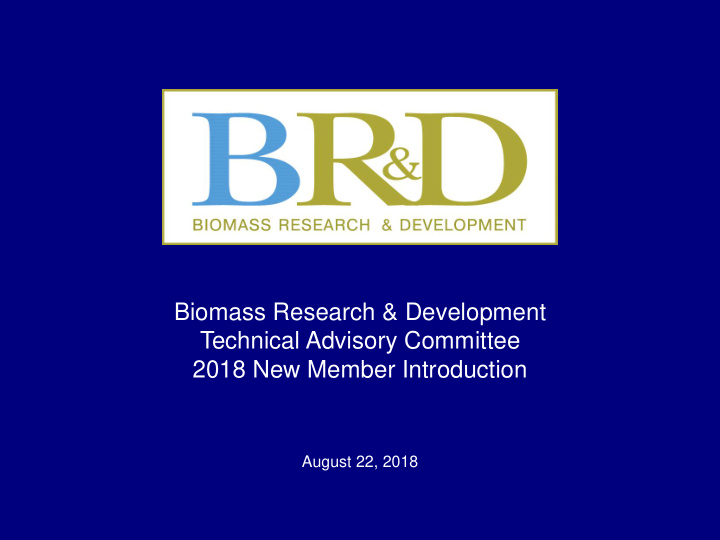



` Biomass Research & Development Technical Advisory Committee 2018 New Member Introduction August 22, 2018
Review • Why does the Biomass R&D Initiative Technical Advisory Committee (“TAC”) exist? • Who makes up the TAC? • What does the TAC actually do? • To whom are we directing our advice and recommendations? • How do we go about evaluating, advising and making recommendations? • What else do we need to be reminded of? 2
Why have a “TAC”? • Because Congress said so, twice • Congress thought it was important for: – The proper conduct of BRDI programs – Getting farther, faster, given resource constraints – Breaking open silos 3
What does the TAC actually do? • Statutory requirements • Reports back to BRDI Board – Delivers quarterly and annual reports – Participates in BRDI Board meetings (quarterly or as scheduled) • Periodic interaction with agencies through RFIs • Evolving activities / focus 4
Other TAC reminders • TAC functions under FACA rules • TAC meetings are public meetings – Meeting notices appear in the Federal Register – Opportunity for non-Committee attendees (general public, special interest, agencies, etc.) • Subcommittee meetings are not public meetings • Elevate public service and collective benefits over personal/private interests and objectives • Role of the Designated Federal Officer (DFO) • Role of the TAC support staff 5
Who makes up the TAC? • Diverse group: – Perspective: academia, government, private industry, NGO (missing finance) – Objective: R&D, commercialization, policy – Interest/Expertise: biomass, conversion technologies, products, markets (upstream, midstream, downstream) – Stage/Phase: from early ideas to steady/growth stage – Regional Interests: diverse geographies • With commonalities: – “Enlightened” about the potential benefits that can be realized with a robust and smart bioeconomy – Well seasoned in our respective fields, industries, perspectives – Willing to “donate” valuable time to the work of the TAC • All members are selected, vetted and appointed 6
Who is our audience? • Statutorily: DOE and USDA – Specifically, BRDI program leadership and staff • Other federal agencies – Specifically, Biomass IWG and OpsCo • Congress – Considering reauthorization and/or funding • Administration – Particularly a new Administration 7
HOW do we conduct TAC business? • Within FACA guidelines & requirements • It’s up to the Committee to determine • Evolves over time – Have moved from an annual report to a set of quarterly topical reports – Provides more interaction with BRDI Board and more in- depth focus on timely, specific topics • Precedent for holding quarterly meetings in D.C. – In most years, have held one quarterly meeting outside D.C., at a location facilitating hands-on exploration of specific sites, programs, facilities, technologies, etc. 8
Quarterly Focus Topics • Committee staff and leadership will use each Quarterly Focus Topic (QFT) to plan the Committee’s quarterly meeting agenda. – Invite agency staff and outside experts to help the Committee collectively understand, frame, and discuss each QFT. • During each quarterly Committee meeting, the Committee will break out into more focused sub-groups (e.g., Feedstocks, Conversion, Products/ Markets/ Systems) to discuss the QFT in more granular detail or from a particular perspective. • Collectively, the Committee develops a framework and key themes/ideas on each QFT for preparation and dissemination of a written brief on each QFT. – Reports synthesize the Committee’s discussion in an issue brief, ideally 2 pages or less. – All Committee members review and comment and adopt the QFT issue brief. 9
Committee Process Phase Prior to or at Q1 Meeting Sub-committees & full Committee committee discuss Establish annual consensus on issues, needs, Quarterly Focus Topics annual QFTs priorities & resources Quarterly Prior to Meeting Committee co-chairs, Identify & solicit Finalize quarterly topical experts & meeting agenda, publish staff, DFO plan agenda resources public notice around QFT Federal program/ agency Subcommittee reports updates & Initial Committee Committee discussion, Quarterly Meeting Committee discussion & prioritization, drafting Conversion Conversion ratifies prior Qtr. prioritization Report Industry, academia, agency subject matter experts, Feedstock Feedstock Committee co-chairs prepare initial report Approve draft Final quarterly report outline/ framework report/ structure Products, Products, issued Committee discussion, Markets & Markets & refinement & framing Services Services of QFT Post-Quarterly Complete, edited Committee co-chairs, Quarterly Report Meeting report circulated to staff, DFO – review & Finalized for Committee Committee Ratification technical editing membership 10
QFT Topic Selection • General: – The topic should be highly relevant for our stakeholders. – The topic should be balanced in depth and scope. – The topic should lend itself to timely distillation into an external communication. – Ideally, at least some of the QFTs should be actionable. • Current QFT: – Opportunities & Challenges for Biobased Plastics R&D 11
Best Practices for Full Committee Meetings • Remember that all full Committee meetings are open, public meetings • Sub-Committee Co-Chairs generally synthesize and present the sub- committee’s input to the larger group • Professional staff assist with note taking & synthesis • Cooperative efforts to hold organized, respectful, open discussion appreciated – Recognition by a Co-Chair to speak – Raise placard sign – Co-Chairs keep a running list of requests to speak/ comment – Try to observe the “rule of thirds” 12
Recommend
More recommend